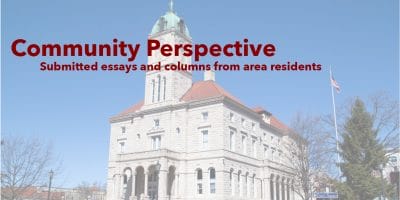
By Randi B. Hagi, assistant editor
Editor’s note: This story was updated on Jan. 14 to accurately describe the candle-making enterprise in Phil Guengerich’s classroom and Bettie Layman’s graduation year.
It started by community members walking down a country road with a wheel attached to the end of a pole. The people who walked that 1.3 miles in the early 1900s, from the town of Linville to that of Edom, counted the number of times the wheel revolved, divided it in two, and thus decided the location of the present-day Linville-Edom Elementary School.
The school first opened in 1912 as the Linville-Edom Consolidated School, with seven elementary grades and one year of high school. Since then, it’s weathered flood, fire, and county redistricting. But now, the fate of Linville-Edom is in question. This spring, the Rockingham County school district will decide whether to spend more than $8 million to renovate the building, or close it and disperse the students among other grade schools nearby.
In response, parents and alumni have organized the group “Keep LEES Open,” to petition the district to preserve the small country school they love. Some of their group members have spoken at public hearings held by the school district and made blue yard signs that can be seen all over the county.
But the building has struggled with drainage-related issues since it opened, thanks to that wheel-determined location. Local resident Jacob Geil had offered to donate a parcel of land for the school east of Edom, on Beard’s Hill — but was turned down in favor of the exact midpoint between the two towns, according to an extensive history of the school written by Mr. and Mrs. Paul Kline, Charles Rodeffer, and Eldon Layman.
Building on Geil’s land up on the hill, “would’ve alleviated their sewer problems and maybe their water problems, yet it was decided it needed to be halfway between Linville and Edom, which put it in a very low kind of swampy area,” explained Phil Guengerich, who taught fifth and sixth grade there from 1970 to 2000. The Linville-Edom Consolidated School was built on that midpoint with limestone quarried from grounds, as well as bricks fired there too.
Linville-Edom became a four-year high school in 1920, with five graduates in that inaugural class. Students commuted by horseback and horse-drawn buggies until the early 1930s, when bus routes were organized.
The school slowly grew, adding a gymnasium, agricultural building with a community cannery, and home economics building in the ‘30s.

History of the Grounds
Disaster struck in 1939, when the main school building burned to the ground. As the Daily News-Record reported on Feb. 21 of that year:
“ … a $30,000 blaze of unknown origin destroyed the Linville-Edom High School building, five miles north of Harrisonburg early yesterday morning as firemen battled successfully to save the nearby school auditorium and gymnasium. A mass of flames when discovered, nothing could be done to save the 12-room structure, which burned to its foundations, destroying thousands of dollars worth of school equipment and school books.”
The cause of the fire was never conclusively determined. Eldon Layman, president of the Linville Edom Alumni Association, started first grade that fall – one of about 325 students in the school. He recalled the different grades being parcelled out into the various auxiliary buildings while reconstruction efforts were underway.
“Some were on the stage, and some were on the floor, and some were in the agricultural building and some were in the home economics building,” Layman said. “So they started to rebuild right away, and they had finished it by the spring of the next year because my first grade class moved into the new classroom about March, I’d say, of 1940.”
Layman said the new building — replete with electricity, indoor bathrooms and heating — felt state-of-the-art to the students in 1940.
“Coming from a family farm, we had at home: outhouses, a black kitchen range where you had to bring in wood and coal, and no heat in the house except a little pot-bellied stove in the living room. At night, you had to take a heated brick and put it in the bed wrapped in a towel to keep your feet warm,” Layman said. “So being able to have a bathroom in the building and to have hot lunches was really great.”
Over the years, Linville-Edom absorbed other small schools: Singers Glen High, Greenmount, Cross Roads, and Edom. Layman was among the last few high school graduates of Linville-Edom, before the county’s high school consolidation sent 9th through 12th graders from the district to Broadway High School. Layman’s wife, Bettie, was in the first class of Linville-Edom students to graduate from Broadway in 1953.
By the time Phil Guengerich began his teaching career in 1970, right after graduating from Eastern Mennonite College, the 30-year old facility was in need of remodeling.
“I was so excited to get my first job. And I took my wife to see the school and she could not believe the condition the school was in. I mean, the halls were dimly lit, of course, there was no air conditioning,” Guengerich said. He remembered a renovation in the 1980s, during which the lighting was updated and air conditioning installed. Still though, it was an ongoing battle to keep the school in good working order.
“They have had problems since the time I even arrived in 1970 … with drainage, water. At times, we had to use trucked-in water,” he explained.

A tight-knit educational community
On that first day in the fall of 1970, Guengerich recalled a mother bringing her son up to introduce them.

“And [she] said, ‘this is Mr. Guengerich, you will call him Mr. Guengerich, and you will respect him at all times, and Mr. Guengerich, if you have any problems with him you let me know, and his problems will get much worse at home.’”
Guengerich looks back on his career with the utmost fondness – at a school in which administrators, educators, families and students looked out for one another.
“It’s just an outstanding community. The people care about education, and quality of education, and take pride in their school,” Guengerich said.
He called upon his own inner mischievous child, from a one-room schoolhouse in Iowa, for inspiration as a teacher.
“I knew in my school, I knew which teachers I learned the most from, were the ones that made it interesting and made it fun, fun to learn. And so you learn rather quickly through trial and error that you can get a lot more by giving them something to work for than trying to avoid punishment,” Guengerich said.
Over the years, this took different forms – sometimes, the students earned vouchers for good grades, behavior, or athletic performance, that they could then exchange for an evening of street hockey and dinner with “Mr. G.” Other times, if they finished their work early, he would take the whole class outside to play soccer.
Guengerich said the school district’s central office sent representatives out to Linville Edom several times during his tenure, “to see what were we doing that made us one of the top schools in the county. And most of the time, we answered, ‘we have administrators here that try to keep the teachers happy within reason, and support the teachers, and then having the parents as part of the educational system.’”
That above-average academic performance continues to this day: for the last three years, according to the Virginia Department of Education, the school has outperformed the district and state averages in reading and science. Last year, the school performed better in math, as well.

Amy Haloskey Martin, now a solo vocalist and lead singer of the band Many Nights Ahead, directly benefited from the school’s high standards. She moved to the area from Maryland in 1999.
“I actually came to Linville-Edom as a first grader and couldn’t read yet,” Martin said. She and other struggling students were organized into small groups and sent to the “reading cottage” to practice. “By the middle of the year, I was at a third grade reading level.”
Beyond a specific program, though, Martin said that Linville-Edom’s entire approach to education, including building strong relationships, characterized her experience.
“It was always this hands on approach to learning that I resonate with as a learner. There was always a project outside of class that was allowing me to bond with my father … there was just a sense of community, togetherness,” Martin explained.

A legacy of relationships
That reputation lasts to this day, said Bethany Versluis Fairfield. Her oldest child already went through Linville-Edom, two are now enrolled, and the fourth will start there next year.
“Linville-Edom is a wonderful historic neighborhood school with deep roots in a rural community. It’s a thriving school. Teachers are excellent – highly educated and experienced, staff are engaged and caring, community involvement is high,” Fairfield wrote in an email to The Citizen. “Linville-Edom is more than a school, it’s a family.”
Ultimately, that’s what seems to be driving the community support to keep Linville-Edom open: more important than its history, or even academic excellence, is the school’s tight-knit nature. It serves as a relational backbone for the community.
Martin remembers a time in second grade when her father – the primary income provider for her family – was recovering from back surgery. Her second-grade teacher, Mrs. Cruz, looked out for the young Martin, offering emotional support.
“I’m just one story,” Martin said. “But I guarantee you, each and every person has their Linville-Edom story.”
Journalism is changing, and that’s why The Citizen is here. We’re independent. We’re local. We pay our contributors, and the money you give goes directly to the reporting. No overhead. No printing costs. Just facts, stories and context. Thanks for your support.














